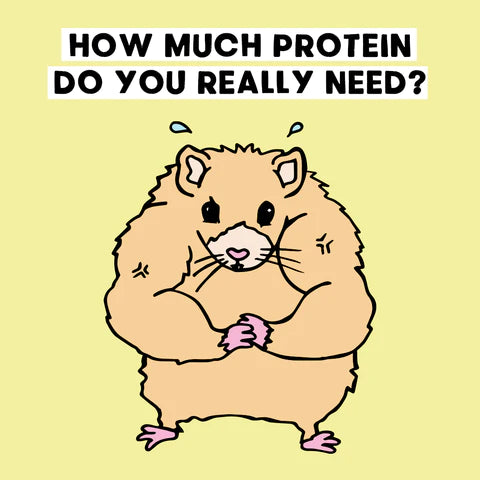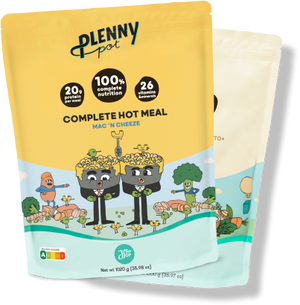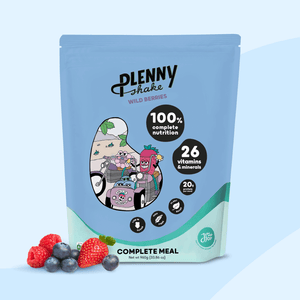Animal-based food production, packaging, transportation, and consumption contribute to numerous environmental problems. Including: greenhouse gas emissions (GHG), farmland erosion, intensive use of water and soil, excess waste creation, underground water pollution, loss of biodiversity - all in all, resulting in significant negative effects on climate change (1-3). Human diets are highly interconnected with environmental sustainability and animal-based products have increasingly become a subject of controversies concerning health, safety, the environment, and animal welfare (4).
Here at Jimmy Joy we strongly believe that as a company we bear the responsibility to present consumers with a tangible solution to this problem. All our products are 100% plant-based, because we want to make sure they are good for your health and for the environment at the same time. A part of our mission is to incorporate sustainability into our every-day operations and ensure that what we do contributes to a positive impact on the society and the environment. Throughout the rest of this article you can read our top 5 science-based reasons why switching to a plant-based diet is the way to go.

1. Plant-based diet is the single best way to reduce your environmental impact
Each year The Global Footprint Network calculates a metric known as Ecological Footprint, which compares the resource demand of individuals, governments, and businesses against what Earth can renew in a year. The result of the calculation is the biocapacity needed to support human resource demand. In 2020, humanity has been living by means of using as much finite ecological resources as if we lived on 1.6 Earths. Moreover, the same calculation determines a specific day, known as the World Overshoot Day, which marks the date when humanity has exhausted the natural budget of Earth's capacity for the year. In 2020, this day falls on the 22nd of August. Thus, for the rest of the year the world is operating in overshoot - maintaining an ecological deficit by drawing down local resource stocks and accumulating carbon dioxide in the atmosphere (10). Click here to read more about Overshoot Day.
The agricultural industry is the largest contributor to the creation of the ecological footprint, resulting in the fact that half of Earth’s biocapacity is used to power our food systems. This issue primarily stems from two underlying factors: resource inefficiency in food production, and food waste (11). Animal agriculture generates 18% of the total greenhouse gas emissions across all industries; an even higher percentage than the transport industry (12).
Animal based products play a critical role concerning sustainability, particularly meat products as they are among the most energy-intensive and ecologically burdensome foods to produce (5). In 2050, the world population is expected to reach 9.7 billion (6). Simultaneously, meat consumption is estimated to rise from 49 kilogram to 52 kilogram annually per person. These global trends show the exact opposite of how the future of human diets should look like. Food production alone contributes to approximately 30 percent of the total environmental impact caused by humans (7, 8). The fact is that based on the projections of future diets, the “business as usual” scenario cannot continue. Research suggests that by means of vegan diets GHG emissions could potentially be reduced by up to 70 percent, or up to 50 percent by means of a vegetarian diet. In monetary terms, it could also avoid climate-related damages of $1.5 trillion (3, 9).
Data on individual food product’s greenhouse gas emissions across the supply chain shows that animal products (i.e. dairy, meat and eggs) account for 83 percent of the carbon footprint generation. More specifically, by far the largest contributor to carbon footprint, red meat, alone creates 62 percent (13). This is due to the fact that production of beef happens to be the most resource inefficient, generating the highest amount of food waste as a by-product. On average, 15,500 litres of water, 25 kilograms of feed, and an extensive amount of land are among others required to produce 1 kilogram of beef. One cow alone produces as much greenhouse gas emissions as 4.5 cars – contributing to soil contamination, water and air pollution, acidification, and extinction of flora and fauna (14).
Hence, coming back to the ecological debt humanity is living in with the planet, it is indisputable that meat consumption is an issue that is essential to be addressed. It is believed that if the global meat consumption decreased by 50 percent the Overshoot Day would be moved by 17 days. For instance, replacing the cultivation of 1 kilogram of beef protein by 1 kilogram of kidney beans protein requires approximately eighteen times less land, ten times less water, nine times less fuel, twelve times less fertilizer and ten times less pesticide (15). All in all, a recent comprehensive analysis by the University of Oxford suggests that adopting a plant-based diet is the single best way to reduce your environmental impact on Earth. Moreover, cutting meat and dairy products from your diet could reduce an individual's carbon footprint from food by up to 73 per cent (16).

2. Feel good and stay healthy
No scientific research confirms the fact that the human body needs meat for its survival. However, a large body of research exists validating the health of plant-based or meatless diets (15, 17, 18). Cardio-metabolic diseases, including heart disease, stroke, obesity, and type 2 diabetes, represent substantial health burdens. Almost one half of deaths caused by cardio-metabolic diseases could be prevented through proper nutrition. It is suggested that following a plant-based diet is among one of the most effective strategies for improving nutrient intake. Evidence shows that plant-based living is highly correlated associated with decreased all-cause mortality and decreased risk type 2 diabetes, stroke, and coronary heart disease (19, 20). Click here to read an article about the world's populations with the longest life-span. Spoiler: most people who live to an age of +100 years follow a plant based diets.
In addition, the studies suggest that plant-based diets are an effective strategy in the treatment of obesity. In a 16-week experiment researchers compared the effect of a plant-based diet on body composition and insulin resistance. The plant-based diet proved to be superior to the control animal-based diet in improving body weight, fat mass, and insulin resistance markers (21).
Furthermore, adopting plant-based diets could help minimize malnutrition and famine. To this day still, 821 million people live in hunger each day (22). With the increasingly growing global population the issues surrounding the amount of resources available to feed humanity are arising. Following standard meat-based diets requires two football fields of space to produce the amount needed to feed 1 person. Whereas, following plant-based diets the same amount of land is needed to feed 14 people. If the entire world population followed a plant-based diet the forest the size of 5 billion football fields worth of land could be restored, or the land could be used to produce the food that will be needed to feed the growing population reaching nearly 10 billion people in 2050 (6).

3. We could save lives of +80 billion animals each year
It is often that people forget about the source of the food on their plates. Research suggests that people who are highly attached to meat possess greater ability to deny animal suffering and see animals they eat as “unfeeling objects'' (23). Animals can feel pain and are capable of feeling and consciousness. Yet, still today Western food culture remains largely resistant to the idea of the reduction of animal-based products (24). To this day meat occupies a central role in Western diets (25). For many people meat is the most important component of the meal (26). Nevertheless, is it essential to acknowledge the fact that eating meat is also a moral case. More than 80 billion animals are raised and slaughtered for human food consumption globally each year (27).
The conservation of terrestrial ecosystems and biological diversity is primarily affected by human consumption of animal-based products. Research identifies livestock production as the single largest
driver of habitat loss, consequently leading to climate change, soil loss, water and nutrient pollution. Particularly, 60 percent of global biodiversity is lost due to clearing of the land for the purpose of livestock production. It is strongly believed that a shift in human diets towards becoming primarily plant-based will lead to enormous impacts on the environment, animal welfare, and restoration of biodiversity (40).

4. Plant-based diets are simply delicious
The negative impacts of meat production and consumption have led to the development of meat substitutes, and several new brands and product introductions. Most known meat substitutes are plant-based (i.e. soy, peas, lupine). In addition, lab-grown meat and insect-based alternatives are in the early development stages, approaching their commercial viability (28-31).
Meat substitutes (also known as replacements, alternatives, or analogues) are plant-based food products that contain proteins made from vegetables, utilizing vegetable pulses as a source of protein. Pulses are the edible seeds of plants belonging to the legume family, such as peas, chickpeas, lentils, beans, and soy, and are particularly high in fibre and protein (32). It is proposed the substitution of meat by plant-based legume alternatives to be the single most effective way of making food consumption more sustainable (16, 33).
Nevertheless, it is suggested that “resistance to the idea of reducing personal meat consumption” persists to be the main reason why consumption of meat continues to be high (34). Plant-based meat alternative producers have primarily been targeting their products towards vegetarians and occasional meat-eaters. Yet, new generation meat analogue brands hope that the consumers with mild to high meat inclusive diets will become their target market (35, 36). Research suggests that consumers who are in favour of meat and who identify as meat-eaters report that they would prefer that meat alternatives highly resemble meat (i.e. lab-grown meat); whereas, consumers in favour of meat substitutes, prefer meat alternatives not to resemble meat (37, 38).
For instance, nowadays we can choose from several different new-generation meat analogue brands. Meat analogues or simulated meat are a specific category within the broader group of meat replacers or meat alternatives, aiming at emulating the taste and texture of meat. They could be regarded as essentially identical substitutes that replace meat as a meal component (25, 39). For instance, Beyond Meat is one of the most popular new generation meat analogue brands. It is completely vegan - made out of pea protein and it also contains beet juice to give the patty the effect of juiciness and ‘bleeding’.
It is important to let go of the reluctance to change a diet and realize that a switch to plant-based offers more and more innovative products and alternatives. Some of our favourite meat replacements are tofu, seitan, and tempeh. We bet you'd be surprised how easy it is once you actually start. A well-known fact is that it takes 21 days to adopt a new habit. So, after a few days or weeks you won't even notice you miss or crave animal-based products. Speaking of plant-based diets, with Jimmy Joy going plant-based is easy, here you can find some easy plant-based recipes we love.

5. Last but not least: Because David Attenborough wants you to…
And let’s face it - who can say no to that man?
Sources
(1) Machovina, B., Feeley, K. J., & Ripple, W. J. (2015). Biodiversity conservation: The key is reducing meat consumption. Science of the Total Environment, 536, 419-431.
(2) Tobler, C., Visschers, V. H., & Siegrist, M. (2011). Eating green. Consumers’ willingness to adopt ecological food consumption behaviors. Appetite, 57(3), 674-682.
(3) Bschaden, A., Mandarano, E., & Stroebele-Benschop, N. (2020). Effects of a documentary on consumer perception of the environmental impact of meat consumption. British Food Journal.
(4) Latvala, T., Niva, M., Mäkelä, J., Pouta, E., Heikkilä, J., Kotro, J., & Forsman-Hugg, S. (2012). Diversifying meat consumption patterns: Consumers' self-reported past behaviour and intentions for change. Meat science, 92(1), 71-77.
(5) Dagevos, H., & Voordouw, J. (2013). Sustainability and meat consumption: is reduction realistic?. Sustainability: Science, Practice and Policy, 9(2), 60-69.
(6) United Nations. (2019). United Nations. Retrieved from Growing at a slower pace, world population is expected to reach 9.7 billion in 2050 and could peak at nearly 11 billion around 2100: https://www.un.org/development/desa/en/news/population/world-population-prospects-2019.html
(7) Rahman, M. H. (2016). Exploring Sustainability to Feed the World in 2050. Journal of Food Microbiology, 7–16.
(8) Tukker, A., & Jansen, B. (2006). Environmental impacts of products: A detailed review of studies. Journal of Industrial Ecology, 10(3), 159-182.
(9) Springmann, M., Godfray, C. J., Rayner, M., & Scarborough, P. (2016). Analysis and valuation of the health and climate change cobenefits of dietary change. Proceedings of the National Academy of Sciences, 4146–4151
(10) Global Footprint Network. (2020). Earth Overshoot Day. Retrieved from Global Footprint Network: https://www.footprintnetwork.org/our-work/earth-overshoot-day/
(11) Global Footprint Network. (2020). Global Footprint Network. Retrieved from Food: https://www.overshootday.org/solutions/food/
(12) Lever, J., & Evans, A. (2016). The Moral Case for Sustainable Development. In Corporate Social Responsibility and Farm Animal Welfare: Towards Sustainable Development in the Food Industry? (pp. 205-222).
(13) Ritchie, H. (2020). Our World in Data . Retrieved from You want to reduce the carbon footprint of your food? Focus on what you eat, not whether your food is local: https://ourworldindata.org/food-choice-vs-eating-local#licence
(14) Esser, J. (2019). Abbot Kinney. Retrieved from Plant-based is a no brainer: https://abbotkinneys.com/guide/four-reasons-to-start-eating-plant-based-food-more-often
(15) Sabaté, J., Sranacharoenpong, K., Harwatt, H., Wien, M., & Soret, S. (2014). The environmental cost of protein food choices. Public Health Nutrition, 1-7.
(16) Springmann, M., Hill, J., & Tilman, D. (2020). Multiple health and environmental impacts of foods. Proceedings of the National Academy of Sciences, 23357-23362.
(17) Yip, C. S. C., Crane, G., & Karnon, J. (2013). Systematic review of reducing population meat consumption to reduce greenhouse gas emissions and obtain health benefits: effectiveness and models assessments. International journal of public health, 58(5), 683-693.
(18) Wyness, L. (2016). The role of red meat in the diet: nutrition and health benefits. Proceedings of the Nutrition Society, 75(3), 227-232.
(19) Frank B Hu, Plant-based foods and prevention of cardiovascular disease: an overview, The American Journal of Clinical Nutrition, Volume 78, Issue 3, September 2003, Pages 544S–551S
(20) Kahleova, H., Levin, S., & Barnard, N. (2017). Cardio-metabolic benefits of plant-based diets. Nutrients, 9(8), 848.
(21) Kahleova, H., Fleeman, R., Hlozkova, A., Holubkov, R., & Barnard, N. D. (2018). A plant-based diet in overweight individuals in a 16-week randomized clinical trial: metabolic benefits of plant protein. Nutrition & diabetes, 8(1), 1-10.
(22) Food Aid Foundation. (2020). Hunger Statistics. Retrieved from Food Aid Foundation: https://www.foodaidfoundation.org/world-hunger-statistics.html
(23) Rosenfeld, D. L., Rothgerber, H., & Tomiyama, A. J. (2020). Mostly vegetarian, but flexible about it: investigating how meat-reducers express social identity around their diets. Social Psychological and Personality Science, 11(3), 406-415.
(24) De Groeve, B., Bleys, B., & Hudders, L. (2019). Okay to promote eating less meat, but don't be a cheat–The role of dietary identity, perceived inconsistency and inclusive language of an advocate in legitimizing meat reduction. Appetite, 138, 269-279.
(25) Slade, P. (2018). If you build it, will they eat it? Consumer preferences for plant-based and cultured meat burgers. Appetite, 125, 428-437.
(26) Elzerman, J. E., Boekel, M. A., & Luning, P. A. (2013). Exploring meat substitutes: consumer experiences and contextual factors. British Food Journa, 700-710.
(27) Thornton, A. (2019). This is how many animals we eat each year. Economic Forum.
(28) Bryant, C. J., & Barnett, J. C. (2019). What's in a name? Consumer perceptions of in vitro meat under different names. Appetite, 137, 104-113.
(29) Van Loo, E. J., Caputo, V., & Lusk, J. L. (2020). Consumer preferences for farm-raised meat, lab-grown meat, and plant-based meat alternatives: Does information or brand matter?. Food Policy, 95, 101931.
(30) Schouteten, J. J., De Steur, H., De Pelsmaeker, S., Lagast, S., Juvinal, J. G., De Bourdeaudhuij, I., ... & Gellynck, X. (2016). Emotional and sensory profiling of insect-, plant-and meat-based burgers under blind, expected and informed conditions. Food Quality and Preference, 52, 27-31.
(31) Hartmann, C., Ruby, M. B., Schmidt, P., & Siegrist, M. (2018). Brave, health-conscious, and environmentally friendly: Positive impressions of insect food product consumers. Food Quality and Preference, 68, 64-71.
(32) Boye, J., Zare, F., & Pletch, A. (2010). Pulse proteins: Processing, characterization, functional properties and applications in food and feed. Food research international, 43(2), 414-431.
(33) Lemken, D., Spiller, A., & Schulze-Ehlers, B. (2019). More room for legume–Consumer acceptance of meat substitution with classic, processed and meat-resembling legume products. Appetite, 143, 104412.
(34) Macdiarmid, J. I., Douglas, F., & Campbell, J. (2016). Eating like there's no tomorrow: Public awareness of the environmental impact of food and reluctance to eat less meat as part of a sustainable diet. Appetite, 96, 487-493.
(35) He, J., Evans, N. M., Liu, H., & Shao, S. (2020). A review of research on plant‐based meat alternatives: Driving forces, history, manufacturing, and consumer attitudes. Comprehensive Reviews in Food Science and Food Safety, 19(5), 2639-2656.
(36) Hoek, A. C., Luning, P. A., Weijzen, P., Engels, W., Kok, F. J., & De Graaf, C. (2011). Replacement of meat by meat substitutes. A survey on person-and product-related factors in consumer acceptance. Appetite, 56(3), 662-673.
(37) Michel, Fabienne, Christina Hartmann, and Michael Siegrist. "Consumers’ associations, perceptions and acceptance of meat and plant-based meat alternatives." Food Quality and Preference 87 (2020): 104063.
(38) Circus, V. E., & Robison, R. (2019). Exploring perceptions of sustainable proteins and meat attachment. British Food Journal.
(39) Ingenbleek, P., & Zhao, Y. (2019). The Vegetarian Butcher: on its way to becoming the world’s biggest ‘meat’producer?. International Food and Agribusiness Management Review, 22(1030-2019-628), 295-308.
(40) Machovina, B., Feeley, K. J., & Ripple, W. J. (2015). Biodiversity conservation: The key is reducing meat consumption. Science of the Total Environment, 536, 419-431.

 Everything You Need In One Meal
Everything You Need In One Meal
 Stay Full For 3-5 Hours
Stay Full For 3-5 Hours




















 Product added to cart
Product added to cart





















